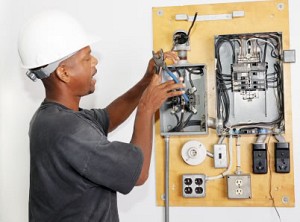Should I Repair or Replace my Electrical Control Panel?

The electrical control panel, or "breaker box," is the heart and mind of your home’s electrical system. The panel connects to the power lines from the utility company and delivers the current to all of the different circuits running throughout your house. The panel is also home to the system’s main safety devices - the circuit breakers - that protect each circuit from overloads and other hazards.
An electrical control panel is a surprisingly simple system that nevertheless can be compromised by any number of problems, from faulty installation to weather and sunlight to plain old obsolescence. All problems with a service panel should be diagnosed and remedied by a qualified electrician, but here are some of the common reasons why you might need to repair or replace a panel or any of its parts.
Damaged Service Cables
The cables running from the power pole to the structural mount on your house are in the domain of the utility company. The cable grouping between the mount and the panel (called SEC, for service-entrance cable) is your responsibility. Problems here may include worn or damaged insulation, a loose cable, or damaged or non-existent clamps or anchors where the SEC meets the meter or service panel. All of these conditions require immediate repair.
Excess Moisture
Water and electricity are as deadly a duo as fire and gasoline. If a water leak or drainage problem brings water onto or near your panel, stay away from the panel and call a pro for help. Evidence of water or excess moisture inside the panel may show up as rust stains on the box or chalky, white corrosion on wiring and other metal parts. Water-damaged panels often must be replaced.
Improper Wiring
Faulty or careless installation can lead to any number of problems that should be repaired in electrical service panels. Common hazards include oversized breakers (such as a 20-amp breaker on a 15-amp circuit), two circuits doubled-up on a single-pole breaker (a code-violating effort to save space), double-pole breakers supplying two single circuits, and wires crisscrossing over the panel’s center. These problems can pose serious risks but are relatively easy to fix.
Poor Manufacturing
Over the years, a few electrical equipment manufacturers have created a legacy of problems for homes with their panels (the now-defunct Federal Pacific Electric company is perhaps the most notorious). Problems with faulty panels have included breakers failing to trip when they should, breakers that fall out of place or are easily damaged and improper installation due to non-standard design (and the installing electrician’s lack of familiarity with the products). If an electrician or home inspector tells you that your electrical control panel is on the "should be replaced" list, he’s probably not just interested in job security. But definitely get a second opinion before making a decision.
Underpowered or Overcrowded Panel
Every electrical control panel has limited space for breakers and a maximum power rating (in amps). Older fuse-type panels typically provided 60 amps of power, followed by standard breaker-type panels at 100 amps. Today, 200-amp panels are recommended for most new construction and upgrades. If your addition or remodeling project calls for adding new circuits, you may need to upgrade to a larger panel. The modest additional expense of going to a 200-amp panel, rather than a 150-amp model, is well worth it, lest you run out of space or power in the future.
If you’re considering a repair or replacement of your electrical control panel, keep in mind that the final word on all home wiring is the local electrical code. You can learn more from your city’s building department or from an experienced local electrician who knows what the rules are for your area.
Updated February 8, 2018.
Looking for a Pro? Call us (866) 441-6648

Electrical Average Costs
Electricians Experiences

Whole House Fan Installation Saves Me Money On Electricity

Light Fixture Installation By An Electrician With A Good Eye For Detail



